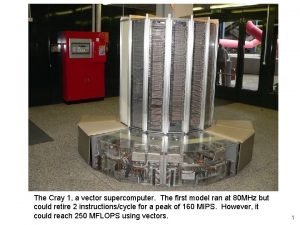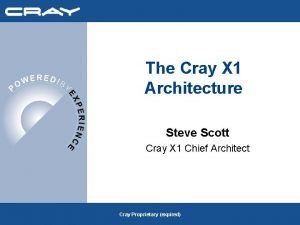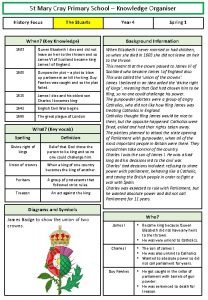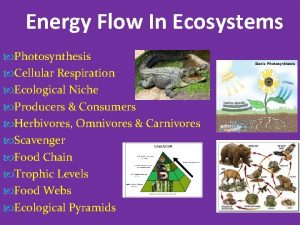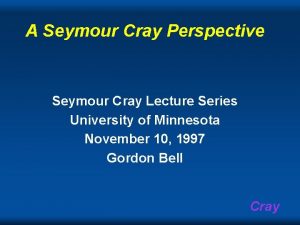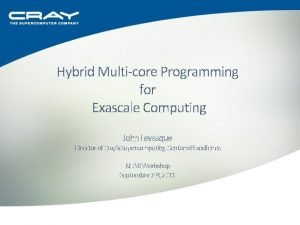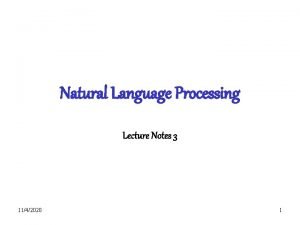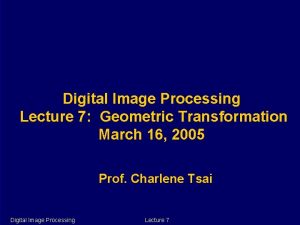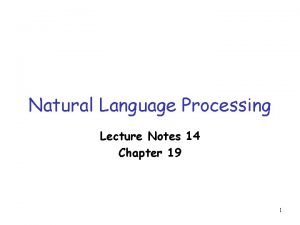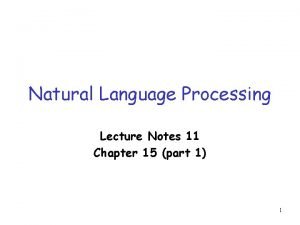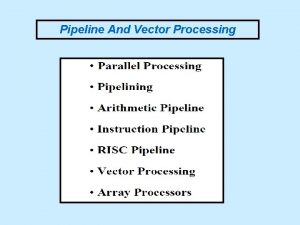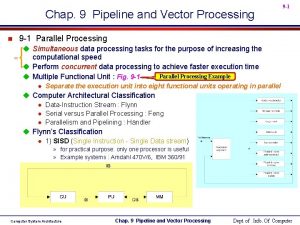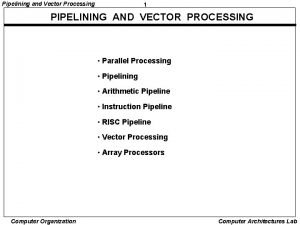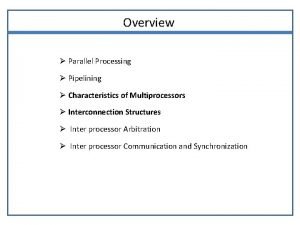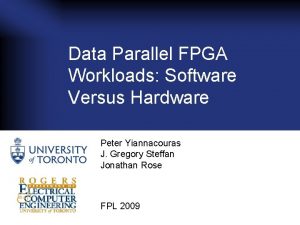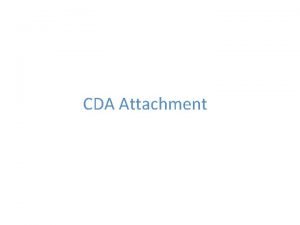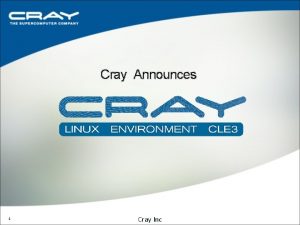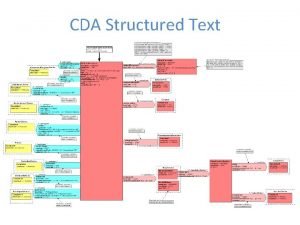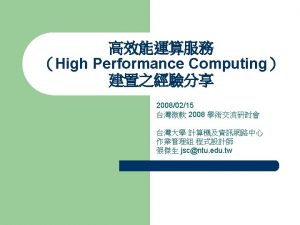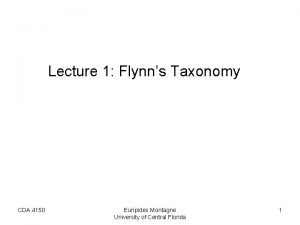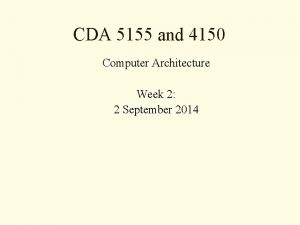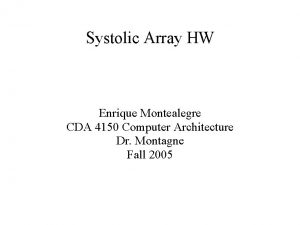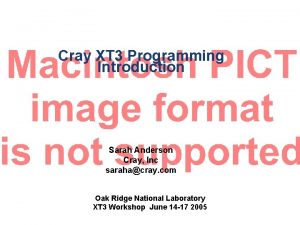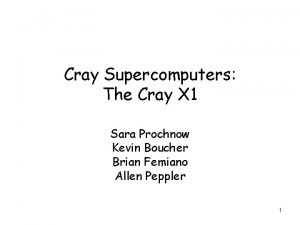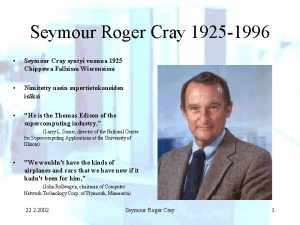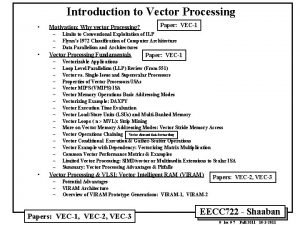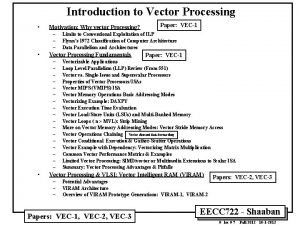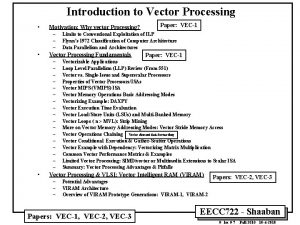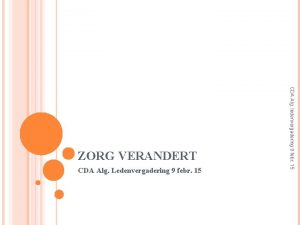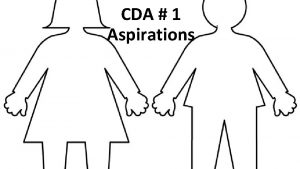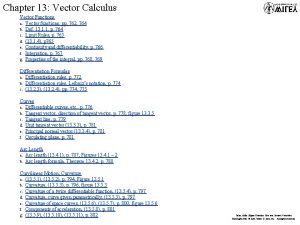CDA 4150 Lecture 4 Vector Processing CRAY like















![Chime - Example #2 n CRAY-1 For I 1 to 64 A[I] = 3. Chime - Example #2 n CRAY-1 For I 1 to 64 A[I] = 3.](https://slidetodoc.com/presentation_image_h2/9e482a273251673851be21a209ad31a4/image-16.jpg)

![Chaining – Example #1 n For J C[J] D[J] END 1 A 1 to Chaining – Example #1 n For J C[J] D[J] END 1 A 1 to](https://slidetodoc.com/presentation_image_h2/9e482a273251673851be21a209ad31a4/image-18.jpg)
![Chaining – Example #2 n For J C[J] D[J] END 1 to 64 A[J] Chaining – Example #2 n For J C[J] D[J] END 1 to 64 A[J]](https://slidetodoc.com/presentation_image_h2/9e482a273251673851be21a209ad31a4/image-19.jpg)










![Program Transformation data dependency FOR I 1 TO n do X A[I] + B[I]. Program Transformation data dependency FOR I 1 TO n do X A[I] + B[I].](https://slidetodoc.com/presentation_image_h2/9e482a273251673851be21a209ad31a4/image-30.jpg)
![Scalar Expansion FOR I 1 TO n do X A[I] + B[I]. . Y[I] Scalar Expansion FOR I 1 TO n do X A[I] + B[I]. . Y[I]](https://slidetodoc.com/presentation_image_h2/9e482a273251673851be21a209ad31a4/image-31.jpg)
![Loop Unrolling FOR I 1 TO n do X[I] A[I] * B[I] ENDFOR X[1] Loop Unrolling FOR I 1 TO n do X[I] A[I] * B[I] ENDFOR X[1]](https://slidetodoc.com/presentation_image_h2/9e482a273251673851be21a209ad31a4/image-32.jpg)
![Loop Fusion or Jamming FOR I 1 TO n do X[I] Y[I] * Z[I] Loop Fusion or Jamming FOR I 1 TO n do X[I] Y[I] * Z[I]](https://slidetodoc.com/presentation_image_h2/9e482a273251673851be21a209ad31a4/image-33.jpg)
- Slides: 33

CDA 4150 Lecture 4 Vector Processing CRAY like machines

Amdahl’s Law a Sequential Execution b c Parallel Execution

Amdahl’s Law (cont. )

Amdahl’s Law (revisited) n Using as a function of n, where = , then =

An extension of Amdahl’s Law in terms of a matrix multiplication equation (AX = Y).

x 1 x 2 x 3 x 4 A 1 A 2 A 3 A 4 = y 1 y 2 y 3 y 4 Compute each vector element in parallel by partitioning. CPU CPU A 1 A 2 A 3 A 4 X X

R. M. Russell, “The CRAY-1 Computer System”, CACM, vol. 21, pp. 63 -72, 1978. n Introduces CRAY-1 as a vector processing Architecture

CRAY -1 Functional Units 64 elements V 0 FP ADD / SUB V 1 MAIN MEMORY (16 -way interleaving) V 2 Vn FP MULT LOGICAL PIPELINE SCALAR REGISTERS

Instruction Operation Function n. ADDV n V 1, V 2, V 3 n. V 1 n. ADDSV (add scalar n V 1, F 0* , V 2 n. V 1 V 2 + V 3 V 2 + F 0 n. V 1 V 2 + V 3 vector) n. MULTV n V 1, n. LV (load vector) V 2, V 3 n V 1, R 1 n. SV (store vector) n R 1, V 1 n. Load V 1 with memory address location starting at address [R 1] n. Store V 1 into memory starting at location [R 1] * F 0 – a floating point number NOTE: Each vector register (Rn) holds floating point numbers.

Timing n A pipeline machine can initiate several instructions within 1 clock tick, which are then being executed in parallel. n Related Concepts: - Convoys - Chimes

Convoy n The set of vector instructions that could potentially begin execution together in one clock period. n Example: LV MULTSV LV ADDV SV V 1, R X V 2, F 0, V 1 V 3, R Y V 4, V 2, V 3 R Y, V 4 Load vector X Vector scalar multiplication Load vector X Add Storing results

Convoy Note: MULTSV V 2, F 0, V 1 || LV V 3, RY is an example of a convoy, where 2 independent instructions are initiated within same chime. LV MULTSV LV ADDV SV V 1, R X V 2, F 0, V 1 V 3, R Y V 4, V 2, V 3 R Y, V 4 Load vector X Vector scalar multiplication Load vector X Add Storing results

Chime n Not a specific amount of time, but rather a timing concept representing the number of clock periods required to complete a vector operation. n CRAY-1 chime is 64 clock periods. - Note: CRAY-1 clock cycle takes 12. 5 ns. 5 chimes would take : 5 * 64 * 12. 5 = 4000 ns

Chime – Example #1 n How many chimes will the vector sequence take? LV MULTSV LV ADDV SV V 1, R X V 2, F 0, V 1 V 3, R Y V 4, V 2, V 3 R Y, V 4 Load vector X Vector scalar multiplication Load vector Y Add Store result

Chime - Example #1 n ANSWER: 4 chimes 1 st chime 2 nd chime 3 rd chime 4 th chime : : LV V 1, RX MULTSV V 2, F 0, V 1 ADDV V 4, V 2, V 3 SV RY, V 4 || LV V 3, RY Note: MULTSV V 2, F 0, V 1 || LV V 3, RY is an example of a convoy, where 2 independent instructions are initiated within same chime.
![Chime Example 2 n CRAY1 For I 1 to 64 AI 3 Chime - Example #2 n CRAY-1 For I 1 to 64 A[I] = 3.](https://slidetodoc.com/presentation_image_h2/9e482a273251673851be21a209ad31a4/image-16.jpg)
Chime - Example #2 n CRAY-1 For I 1 to 64 A[I] = 3. 0 * A[I] + (2. 0 + B[I]) * C[I] n To execute this: 1 st chime : V 0 2 nd chime : V 1 3 rd chime 4 th chime V 3 V 4 : V 5 V 6 V 7 : A A B 2. 0 + V 1 3. 0 * V 0 C V 3 * V 5 V 4 + V 6 V 7 Can initiate operations to use array values immediately after they have been loaded into vector registers.

Chaining n Building dynamically a larger pipeline by increasing number of stages. V 0 V 1 V 4 + V 5 V 3 * 3 stages 7 stages
![Chaining Example 1 n For J CJ DJ END 1 A 1 to Chaining – Example #1 n For J C[J] D[J] END 1 A 1 to](https://slidetodoc.com/presentation_image_h2/9e482a273251673851be21a209ad31a4/image-18.jpg)
Chaining – Example #1 n For J C[J] D[J] END 1 A 1 to 64 A[J] + B[J] F[J] * E[J] are independent!! C 64 V 0 V 1 1 E + B * No chaining - these V 2 V 4 F D 64 V 3 * V 5
![Chaining Example 2 n For J CJ DJ END 1 to 64 AJ Chaining – Example #2 n For J C[J] D[J] END 1 to 64 A[J]](https://slidetodoc.com/presentation_image_h2/9e482a273251673851be21a209ad31a4/image-19.jpg)
Chaining – Example #2 n For J C[J] D[J] END 1 to 64 A[J] * B[J] C[J] * E[J] C V 2 1 A B 64 V 0 V 1 * + V 3 E V 0 D

Latency It takes 8 units to get the result to here 1 A 64 V 0 + B V 2 C V 1 1 6 V 0 and V 1 To functional unit ADD TIME 1 Result to V 2

More Chaining and Storing Matrices Thanks to Dusty Price

Sequential Approach… v 2 v 0 + * v 1 v 4 v 3 time 1 6 add 8 1 1 7 1 mul 9 64 Elements in sequence: Ts = 64 * (8 + 9) = 1088

Using Pipeline Approach… v 0 + v 3 Using pipelining it takes 8 units of time to fill pipeline and produce first result, each unit of time after that produces another result Tp+ = 8 + 63 v 5 The multiplication pipeline takes 9 units of time to fill, and produces another result after each additional unit of time v 1 8 v 3 * v 4 Tp* = 9 + 63 9 The combination of the two Tp = Tp+ + Tp* = 8 + 63 + 9 + 63 = 143

Pipeline plus Chaining… v 2 v 0 + v 1 v 3 time 1 6 add 1 v 4 * 1 7 mul 1 Using the chaining technique, we now have one pipeline. This new pipeline takes 17 units of time to fill, and produces another result after each unit of time. Tc = 17 + 63 = 80 8 9 Operation using Chaining Tc = 17 + 63 = 80

Review of time differences in the three approaches… Sequential: Ts = 17 * 64 = 1088 Pipelining: Tp = 8 + 63 + 9 + 63 = 143 Chaining: Tc = 17 + 63 = 80

Storing Matrixes for Parallel Access (Memory Interleaving) Matrix A 11 A 12 A 13 A 14 A 21 A 22 A 23 A 24 A 31 A 32 A 33 A 34 A 41 A 42 A 43 A 44 4 Memory Modules M 1 M 2 M 3 M 4 A 11 A 21 A 31 A 41 A 12 A 22 A 32 A 42 A 13 A 23 A 33 A 43 A 14 A 24 A 34 A 44 One column of the matrix can be accessed in parallel.

Storing the Matrix by Column… Matrix A 11 A 12 A 13 A 14 A 21 A 22 A 23 A 24 A 31 A 32 A 33 A 34 A 41 A 42 A 43 A 44 4 Memory Modules M 1 M 2 M 3 M 4 A 11 A 12 A 13 A 14 A 21 A 22 A 23 A 24 A 31 A 32 A 33 A 34 A 41 A 42 A 43 A 44 One Row can be accessed in parallel with this storage technique.

Sometimes we need to access both rows and columns fast… Matrix A 11 A 12 A 13 A 14 A 21 A 22 A 23 A 24 A 31 A 32 A 33 A 34 A 41 A 42 A 43 A 44 4 Memory Modules M 1 M 2 M 3 M 4 A 11 A 12 A 13 A 14 A 21 A 22 A 23 A 34 A 31 A 32 A 43 A 44 A 41 By using a skewed matrix representation, we can now access each row and each column in parallel.

Sometimes we need access to the main diagonal as well as rows and columns… Matrix 5 Memory Modules A 11 A 12 A 13 A 14 A 21 A 22 A 23 A 24 A 31 A 32 A 33 A 34 A 41 A 42 A 43 A 44 M 1 M 2 M 3 M 4 A 11 A 12 A 13 A 14 A 21 A 22 A 23 A 24 A 31 A 32 A 33 A 41 A 42 A 34 A 43 A 44 M 5 At the cost of adding another memory module and wasted space, we can now access the matrix in parallel by row, column, and main diagonal.
![Program Transformation data dependency FOR I 1 TO n do X AI BI Program Transformation data dependency FOR I 1 TO n do X A[I] + B[I].](https://slidetodoc.com/presentation_image_h2/9e482a273251673851be21a209ad31a4/image-30.jpg)
Program Transformation data dependency FOR I 1 TO n do X A[I] + B[I]. . Y[I] 2 * X. . X C[I] / D[I]. . P X+2 ENDFOR removes data dependency FOR I 1 TO n do X A[I] + B[I]. . Y[I] 2 * X. . XX C[I] / D[I]. . P XX + 2 ENDFOR
![Scalar Expansion FOR I 1 TO n do X AI BI YI Scalar Expansion FOR I 1 TO n do X A[I] + B[I]. . Y[I]](https://slidetodoc.com/presentation_image_h2/9e482a273251673851be21a209ad31a4/image-31.jpg)
Scalar Expansion FOR I 1 TO n do X A[I] + B[I]. . Y[I] 2 * X. . ENDFOR data dependency FOR I 1 TO n do X A[I] + B[I]. . Y[I] 2 * X[I]. . ENDFOR removes data dependency
![Loop Unrolling FOR I 1 TO n do XI AI BI ENDFOR X1 Loop Unrolling FOR I 1 TO n do X[I] A[I] * B[I] ENDFOR X[1]](https://slidetodoc.com/presentation_image_h2/9e482a273251673851be21a209ad31a4/image-32.jpg)
Loop Unrolling FOR I 1 TO n do X[I] A[I] * B[I] ENDFOR X[1] A[1] * B[1] X[2] A[2] * B[2]. . X[n] A[n] * B[n]
![Loop Fusion or Jamming FOR I 1 TO n do XI YI ZI Loop Fusion or Jamming FOR I 1 TO n do X[I] Y[I] * Z[I]](https://slidetodoc.com/presentation_image_h2/9e482a273251673851be21a209ad31a4/image-33.jpg)
Loop Fusion or Jamming FOR I 1 TO n do X[I] Y[I] * Z[I] ENDFOR I 1 TO n do M[I] P[I] + X[I] ENDFOR a) FOR I 1 TO n do X[I] Y[I] * Z[I] M[I] P[I] + X[I] ENDFOR b) FOR I 1 TO n do M[I] P[I] + Y[I] * Z[I] ENDFOR
 Cray vector processor
Cray vector processor 01:640:244 lecture notes - lecture 15: plat, idah, farad
01:640:244 lecture notes - lecture 15: plat, idah, farad Cray 1 architecture
Cray 1 architecture St mary cray primary
St mary cray primary Cray 1
Cray 1 Crayfish
Crayfish Cray-xmp-144
Cray-xmp-144 John levesque cray
John levesque cray Graham cray
Graham cray Graham cray
Graham cray St mary cray primary school
St mary cray primary school Natural language processing nlp - theory lecture
Natural language processing nlp - theory lecture Image processing lecture notes
Image processing lecture notes Natural language processing lecture notes
Natural language processing lecture notes Natural language processing nlp - theory lecture
Natural language processing nlp - theory lecture Natural language processing lecture notes
Natural language processing lecture notes Fluorocein
Fluorocein Natural language processing lecture notes
Natural language processing lecture notes Natural language processing lecture notes
Natural language processing lecture notes What are i and j in vectors
What are i and j in vectors Fsica
Fsica Vector resolution examples
Vector resolution examples What is a position vector?
What is a position vector? Shwetha bhandari
Shwetha bhandari Pipeline vector processing
Pipeline vector processing Pipeline processing in computer architecture
Pipeline processing in computer architecture Pipeline and vector processing
Pipeline and vector processing Interconnection structure of multiprocessor
Interconnection structure of multiprocessor Vector processing workloads
Vector processing workloads Top.down processing
Top.down processing Bottom up processing vs top down processing
Bottom up processing vs top down processing Bottom up processing example
Bottom up processing example Neighborhood processing in image processing
Neighborhood processing in image processing Primary, secondary and tertiary food processing
Primary, secondary and tertiary food processing
